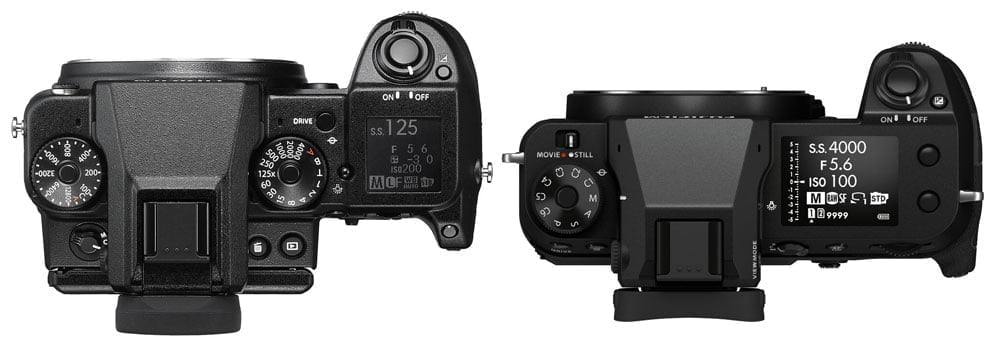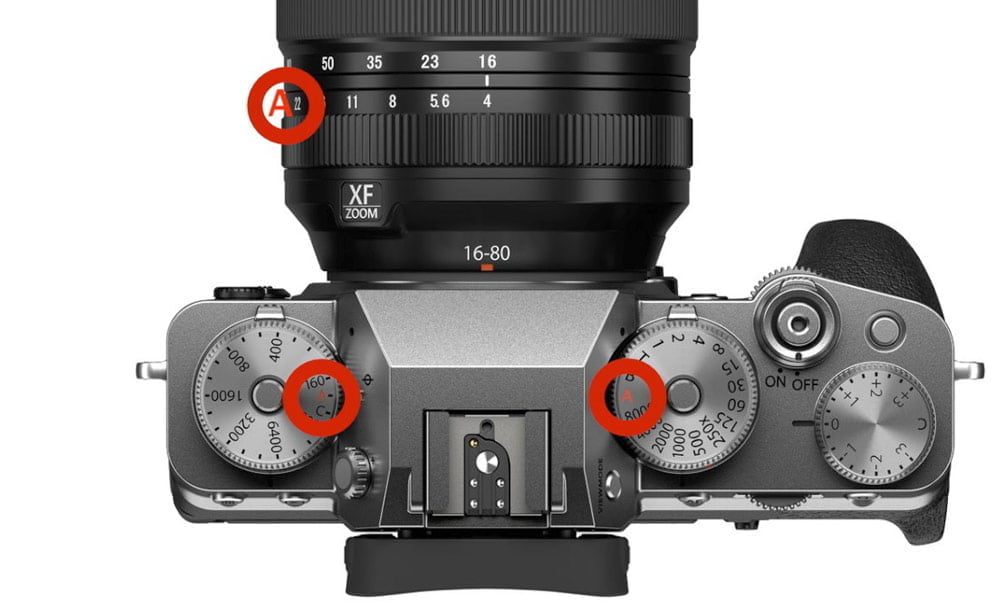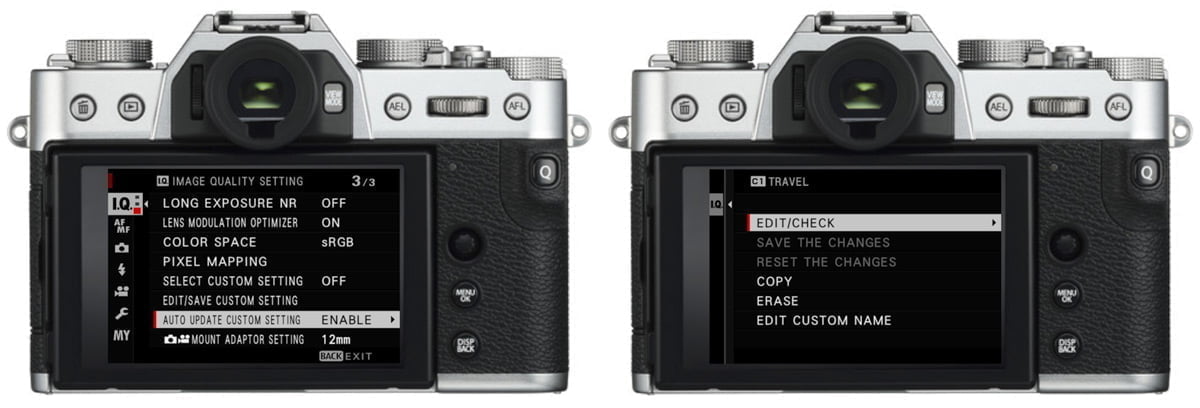Disclosure: This post may contain affiliate links. I earn a small commission of product sales to keep this website going.
Sorry for the hyperbole in the title but Fujifilm has been making some surprisingly drastic changes in their latest X & GFX camera designs.
The X-S10 was the first to ditch the controls we were all familiar with and went with a “standard” PSAM dial.
The X-E4 doesn’t seem to have any controls at all (relative to the rest).
Then along came the GFX50S II, followed shortly by the X-H2S, joining the GFX100 & 100S as cameras unrecognizable as Fujifilm cameras. No shutter speed dial, no exposure compensation dial, just a PSAM dial and an “exposure compensation button” like the flop X-H1 had.

These new PSAM dials are also inscribed with C1-Cx, to help you quickly rotate to one of your saved Custom Settings. As if doing so in the Q menu wasn’t fast enough?
So let’s talk about these Custom Settings – what they were and where they’re going.
Building the brand
Look at any Fujifilm blog or YouTube video from the early years of Fujifilm X cameras. They all share two common points of enthusiasm, other than just “looking cool”:
- The analog exposure controls get the “tech” out of the way, making the photographic process feel more creative, moving the photographer closer to the core of photography.
- The custom settings enable you to get outstanding JPEGs in the camera, negating the need for hours of post-processing.
This departure from what their competitors were doing built an extremely loyal following of passionate photographers.
It really carved out a niche for the brand, appealing to photographers who wanted to get back to the roots of photography. This built the brand.
Nowhere, at least that I’m familiar with, did any of these enthusiastic photographers say, “I really love these cameras, but man I wish they had a PSAM dial.” On the contrary, photographers praised the brand for not having one.
Likewise, no one said, “I really wish these custom settings would allow me to save an exposure mode.”

The story of the Custom Settings
Fujifilm’s custom settings differed from other brands. And their photographers loved this.
They were all about customizing the Film Simulations so you didn’t have to post-process your photos. Ritchie Roesch over at Fuji X Weekly built an entire website and app around this capability.
Out on a nature walk? Use your personal Vibrant setting to photograph flowers and then quickly switch to your personal Black & White setting to photograph dramatic clouds and shadows over a distant mountain. See a street protest on your way home? Select your subdued Documentary setting. Get home, transfer them to your computer, and you’re done.
Those other brands? All their custom settings were about focus & exposure modes.
That’s because, in order to adjust those things, you usually have to go into menus or press certain combinations of buttons. Their custom settings let you quickly save those combinations depending on what your focus/exposure needs were so you didn’t have to spend too much time in these menus.
But Fujifilm didn’t need their custom settings to do this.
The exposure triangle was at your fingertips with the aperture ring, shutter speed dial, ISO dial, and Exposure Compensation dial. You could set them with the camera powered off. Focus mode switches and a plethora of customizable controls meant you didn’t have to go into the menus to change much of your daily settings at all.
This ease of control meant that Fujifilm’s custom settings could be about the creative side of photography and not the technical.
At least, that’s how it used to be.
A departure from the norm
My first experience with Fujifilm’s new custom setting system was with the X-S10, which I purchased for video use. I didn’t really pay much attention to or even program its C1-C4 modes, located on the new mode dial.
Then I tried out the X-E4, which I promptly returned, and had my first real frustrations with the new custom settings. I couldn’t wrap my head around it. Later, in updating my secondary body to the X-T30 II, I forced myself to learn the new custom settings system. It’s remarkably different than my primary body, an X-T4.
Fujifilm’s new custom settings force you to save everything in your Shooting & Focus menus. Now you must have an MF assist mode, drive mode, AF area, etc., associated with your creative choices, even though they’re irrelevant to that. And on cameras with a PSAM dial, you must have an exposure mode tied to a custom setting.
This really drove me crazy when I first took out the GFX50S II. I wanted to shoot in a certain style but couldn’t figure out how to change exposure modes while using that style. I had saved Aperture Priority to that style but wanted to go to Manual. It was later I discovered I could change exposure modes in the Q menu, but what an ordeal to go through.
And with the X-T30 II, I’m using the Auto Update feature so these saved shooting & focus settings don’t bite me in the ass; you can read this article for more on that. But I lose my saved styles doing that – the whole reason for using these custom settings in the first place.

Where is Fujifilm going?
I don’t want to say Fujifilm’s business decisions are wrong; I’m not in a place to do that. I don’t have their research, numbers, or reports. I’m not on their board. And I fully understand that the digital camera market is in a strange, awkward place right now.
And I also don’t want to sound like my dissatisfaction is going to make me leave the brand. I’m still happy when I pick up a Fujifilm camera. I know they have their reasons for making these changes, but I have yet to understand why they’ve seemingly abandoned Kaizen.
Perhaps they see their only way to survive is being able to poach photographers from other brands, and having familiar control layouts will make them more appealing. Maybe research has shown that to appeal to beginner photographers purchasing their first camera, this new layout will be more successful. And maybe manufacturing costs are unsustainable, forcing them to minimize the moving parts. Maybe it’s all of the above.
In changing how their physical controls are laid out, and removing many of them, now you must go into the menus to change basic settings. Hence why they’re now part of custom settings like other camera brands that similarly lack those exterior controls.
But by doing this, it seems they might be abandoning the entire reason that a loyal group of photographers brought them this far. The photographers who preached about how liberating it is to have physical controls for the basic exposure triangle, and the photographers who sang about how amazing it is to not have to post-process photos thanks to the custom settings abilities. The photographers who loved Fujifilm precisely for the reason that they were so unique. They are no longer unique.
In removing those controls, and fundamentally changing the reason for the custom settings, the photographers who built the brand will have to go back to “square one” if they upgrade. New cameras aren’t operationally that much different from any other brand. Hang on to your old cameras as long as possible, or forget the reason you fell in love with the brand in the first place.
Where’s the joy in that?

TS
Thursday 2nd of November 2023
Ugh, I "upgraded" from the xt3 to xt5, mostly because of ibis and better autofocus. I hadn't even realized the change in custom settings! This explains why I have a lot of weird blurry shots, since my min auto iso shutter speed is not synced across custom slots. What a disappointment ? I've owned xt1, xt2 and xt3 and also have the 100v. I think I might go back to the xt3 for now.
John Peltier
Friday 3rd of November 2023
Fujifilm, are you listening? Your choices here to join the bandwagon have crippled your long-time, loyal users!
Sorry to hear that, you're not alone, and it's been happening to me too - old habits are hard to break!
Martin
Saturday 25th of March 2023
Hi John I'm a bit like Thomas and recently bought an X-S10 as I wanted a proper camera again after having had some DSLRs a few years ago. I wasn't familiar with the Fuji system but I liked the look of the film styles, and maybe the PASM dial subconsciously meant I thought it would be less of a learning curve, the X-S10 ticked a lot of boxes.
So I hadn't used the old custom settings but I think of the new custom system as being designed for saving "situations" rather then just creative styles... e.g. a setting for landscape, family snaps, low light; where you can save the desired focus, metering, ISO profile etc... I don't know if that's what Fuji were thinking. I expect if I had used the old system I would think differently! I still learning...
One thing that annoys me is that if you twiddle with many settings while in one of the PASM modes on the dial, I can't see an easy way to zero them all back to start from scratch again ( the reset menu resets too many things) - any ideas?
Thanks Martin
Grey
Sunday 30th of April 2023
@John Peltier, I’m thinking about upgrading from my x-t2 to the x-t5. Is the “new” custom settings process in the x-t5 or has Fuji retained the one I’m used to? Thanks.
John Peltier
Wednesday 29th of March 2023
Yeah for people coming into the Fujifilm system now, not having used the custom settings in old cameras, it’s not a big deal. Just a huge headache for the rest of us :) One of the new problems is like you mention, there’s no good way to track your changes. I keep a spreadsheet with my original settings in case it gets too far gone.
john
Tuesday 14th of March 2023
I would add, it would be nice to have which film simulation and custom settings used in the metadata info section that you could review. If you are shooting two different BW films and different K temperatures this would greatly help.... just saying.
Blaise
Sunday 5th of February 2023
This really surprised me with the X-S10. The whole reason I got the camera was to play with those “film recipes” over at Fuji X Weekly.
The craziest things are stored in C1-C4 custom settings. I just learned that even Auto ISO sub-settings are stored per custom setting. So instead of 3 different auto ISO settings (more than enough!!) you actually have something like 12.
Another biggie is the “mount adapter setting” which tells the camera what focal length you’re using with “dumb” lenses or 3rd party adapted lenses. This is relevant not only for EXIF data, but I believe it also helps optimize IBIS. Imagine switching out your vintage prime lenses, taking the time to set the mount adapter setting, then having to do that *all over again* when you switch to your black & white film recipe.
John Peltier
Monday 6th of February 2023
Yes, everything needs to be saved and gets changed when you switch custom settings. I've been surprised way too many times by this, and your third-party lens is a great example.
Thomas
Wednesday 18th of January 2023
Dear John
As a quite happy new owner of a X-S10 I am a newcomer to the Fuji system. I did not select the X-S10 due to the "mainstream" PASM dial or the new layout in general. On the contrary, I would have preferred the "traditional" Fuji layout. But the features/price combination of the X-S10 is perfect for my intended use case.
BUT: Why do you say that you cannot switch from Aperture priority to Manual in a Custom Setting (e.g. C1 set to A)? I can switch between P/A/S/M modes using the QUICK MENUE without having to leave the Custom Setting I am in (e.g. C1) on my X-S10.
Am I missing something? Please tell me if I do.
Otherwise very instructive. Thank you.
Besides, may present setup is to use the QUICK MENU a lot, also for selecting the film simulations etc., and to assign the Quick Menu to the video button, because it is the easiest button to be found in a purely tactile manner, as opposed to the standard Q button (right next to the ISO button).
Also, I have assigned the ISO values to the left wheel. Certainly not as good as the original Fujifilm wheel, since you can not see the set value from the exterior.
Kind regards,
Thomas
John Peltier
Wednesday 18th of January 2023
Oh yeah thanks for pointing that out - I "accidentally" discovered I could change the exposure mode in the Q menu shortly after publishing this article but never updated it. Thank you for your comments!